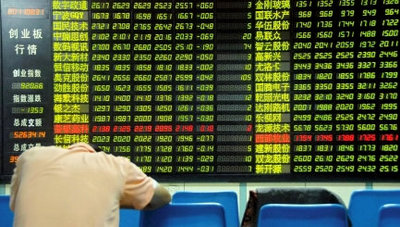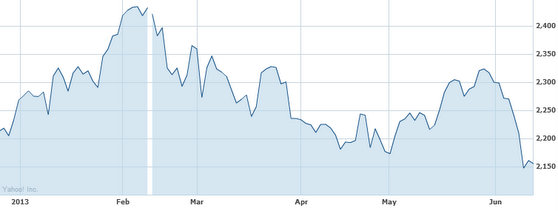Main reference: Story in Sinafinance
THE RECENT sharp selloffs in China put the benchmark Index below the 2,000 level for the first time in half a year.
But this head-turning level is likely to only be temporary.
This may be hard to imagine, especially since the benchmark Shanghai Composite Index – chief tracker of A- and B-shares listed in Shanghai and Shenzhen – recently saw its biggest one-day loss in 46 months.
The nearly four-year-old ChiNext Board, often referred to as “China’s Nasdaq,” has also seen steep corrections of late, and across the equities spectrum non-ferrous metals, banks, brokerages and property developers have been bearing the brunt of investor selloff behavior these days.
 China shares recently saw a one-day drop not seen in 46 months. Photo: huaxiOne “positive” to be taken from this phenomenon is that these are the very themes that have added the most share value of late, so panic fleeing from their higher pricing environment suggests that there is still some picking and choosing in selling behavior and it’s not merely a comprehensive, across-the-board rejection of all Chinese equities.
China shares recently saw a one-day drop not seen in 46 months. Photo: huaxiOne “positive” to be taken from this phenomenon is that these are the very themes that have added the most share value of late, so panic fleeing from their higher pricing environment suggests that there is still some picking and choosing in selling behavior and it’s not merely a comprehensive, across-the-board rejection of all Chinese equities.
One of the biggest reasons for the recent bloodletting is not so much a factor of the respective attractiveness – or lack thereof – of individual counters.
Instead it is primarily a problem of liquidity.
Recent pronouncements by the People’s Bank of China (PBOC) – the country’s Central Bank – that is was satisfied regarding current levels of liquidity with suggestions that it supported a tighter monetary policy than was the norm of late, have sent shockwaves through domestic financial markets.
Add to that the fact that interbank lending rates have skyrocketed and rumors of a larger-than-anticipated NPL burden saddling smaller banks and local governments has added to overall investor anxiety.
With no hope of another major infusion on the horizon from the PBOC, there is little likelihood of a liquidity improvement and this could extend into July if all things remain equal.
From a technical standpoint, the latest liquidity crunch and uninspired investor sentiment offers little reason to be optimistic that a rapid rebound is on the horizon.
However, there is reason for some sanguinity that things likely won’t get worse, but at the same time aren’t going to get much better anytime soon.
 Recent China shares performance. Source: Yahoo Finance
Recent China shares performance. Source: Yahoo Finance
While the Central Bank is now doing its best to tighten monetary policy and improve the quality of lending decisions across the land, another countervailing force is at work.
It has been two-thirds of a year since bourses in Shanghai and Shenzhen rang the opening bell on a newcomer, and the country’s capital market watchdog, the China Securities Regulatory Commission (CSRC), has been hinting for several months that the second half of this year would usher in the return of IPOs to the land.
As for the timing of the return of firms going public, many point to July as being the principal target.
It is very likely that the two forces will find a way to usher in a reasonably healthy return to new share launches with adequate funding capital to back them up.
At the same time, the interim reporting season is about to unfold and if several listcos surprise on the upside – which market watchers are hoping for -- this could bring a sigh of relief on the liquidity side as well as a more robust-than-anticipated return to the season of IPOs.
Therefore, the recent sub-2,000 status of the benchmark Index is likely to be a short-lived phenomenon.
See also:
90-Year-Old Chinese Investor Shares Trade Secrets







